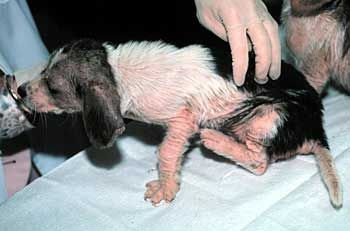
Dog Mange
Veterinarian Reviewed on June 17, 2012 by Dr. Janice Huntingford
Contents |
Dog Mange
Mange is a contagious Dog Skin Disease that is caused by parasitic mites. The mites attack their host by embedding themselves into the hair follicles and/or skin of the host. Usually, this disease only affects domestic pets. But, the parasites can also spread to wild animals and humans.
Demodectic Mange
Demodectic mange is caused by an overpopulation of mites that cannot be controlled by a dog’s immune system. This mite occurs naturally in the hair follicles of dogs, and they never cause problems in most dogs. The overpopulation can be caused by many factors, such as stress, weakened immune system, and malnutrition.
The most common symptoms of demodectic mange are: small patches of hair loss, inflammation, mild irritation, itching, and secondary infections. In rare cases, life-threatening conditions may occur due to demodectic mange. In minor cases, itching doesn’t occur, but redness, pustules, scaling, and/or hair loss can occur.
Demodectic mange doesn’t pose any real threat to humans or any other dog, as the mites are breed specific.
If the demodectic mange is being caused by an impaired immune system, the mange may clear up once the immune system of a dog matures. Even though the mange can be corrected naturally, most veterinarians recommend that the dog receives treatment.
Sarcoptic Mange
Also known as canine scabies, sarcoptic mange is caused by a burrowing mite that is highly contagious and can infest humans and other domestic pets, such as cats, horses, pigs, sheep, other dog breeds, and more.
When these mites burrow into the skin of dogs, they cause severe itching that can crust. These sores can quickly become infected, thus causing hair loss and other complications.
The most common place for the crusting and hair loss to occur is the elbows and the ears. The skin can become intensely damaged due to the scratching and biting the dog may be doing because of the irritation. The itching and biting can also cause more secondary infections in the dog as well.
Sarcoptic mange can become chronic, if left untreated. If a dog is infested by chronic sarcoptic mange, the dog is most likely to be in very poor condition.
To prevent infestation of others, the infested dog needs to be completely isolated. To treat a dog with sarcoptic mange, there are medications, such as topical rinses and oral medications. Many of these medications can be prescribed by a veterinarian. There are also natural and holistic methods, such as Neem Soap.
Cheyletiella Mange
Cheyletiella mange, also known as walking dandruff, is a highly contagious mange that is caused by mites. These mites are reddish in color and can be seen under a magnifying glass. The dandruff usually appears around the neck, head, and back of a dog and can cause mild itching. This mange is relatively short-lived and the mites die shortly after exiting a host.
Diagnosis
Mange can easily be identified by a vet when they take sample scrapings from the infested area. The samples are then placed under a microscope to identify the specific mites that are causing the mange. Diagnosis can also be made from an examination of symptoms if no mites are visible.
Prevention
A dog can easily be protected from mange with regular visits to a vet and vaccinations. Keeping distance between dogs that are known to be infested can also be an effective tool to prevent mange.
Sign up for our newsletter and receive more articles and the latest pet health updates and special offers.
Our Expert
 Dr. Janice Huntingford
Dr. Janice HuntingfordJanice Huntingford, DVM, has been in veterinary practice for over 30 years and has founded two veterinary clinics since receiving her Doctor of Veterinary Medicine at the Ontario Veterinary College, University of Guelph. She has studied extensively in both conventional and holistic modalities. Ask Dr. Jan

